This was published 7 years ago
Suffolk, England: The gourmet food destination the English keep to themselves
By Daniel Scott
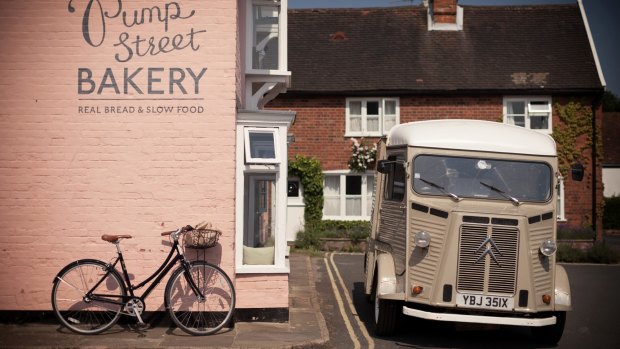
Pump Street Bakery in Orford, Suffolk. Credit: Rod Edwards
Although it's within easy striking distance of London, bordered by Essex in the east, Norfolk to the north and Cambridgeshire in the west, Suffolk is a destination that the English keep largely to themselves, with seaside towns like Southwold and Aldeburgh much loved for family holidays.
Yet, ironically, in spite of growing up in England, it has taken my long stint living in Australia to prompt my first journey there.
For this four-day trip, I've got my oldest mate and Suffolk aficionado, Phil, and his little convertible Peugeot, to unveil its low-lying countryside, rural villages, and the coast and hinterland heaths that together form an Area of Outstanding Natural Beauty.
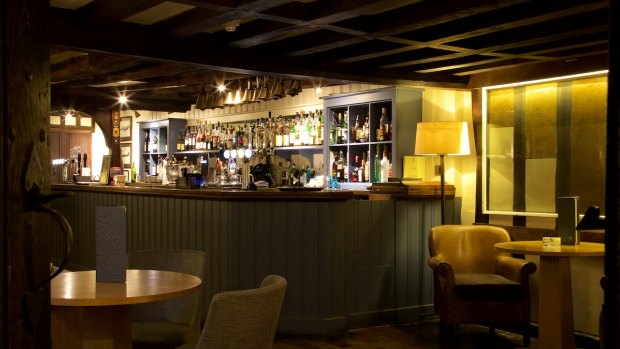
The Swan at Lavenham. Credit: nicksmithphotography.com
But for two would-be middle-aged gastronomes, there is another important aim: to munch and quaff our way through Suffolk by dropping in on its top restaurants.
We base ourselves at The Swan, a hotel occupying a set of three half-timbered, 15th-century houses in the medieval village of Lavenham, about two hours drive north-east of London.
The Swan is one of those olde-world English buildings that puts you immediately at your ease, where you can imagine grandpa nursing a pint of real ale while grandma sips tea from a porcelain cup.
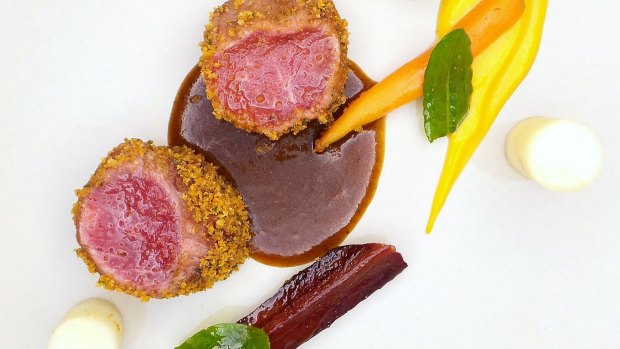
Lamb noisette at Maison Bleue, Bury St Edmunds.
It's a hotel where, if the walls had mouths as well as ears, there would be murmurings about the state of the 15th and 16th century wool trade, that made Lavenham one of the richest towns in Britain at the time. There would be the echo of chattering travellers pausing at the former coaching inn, that had stabling for 50 horses in 1830, and the excited babble of US airmen charming the bloomers off local women during World War II.
Just mind your head on those low beams if you're tall.
Time and again I duck in time to avoid brain damage but still manage to forge straight into the doorframe of our room twice, thudding my forehead against it as if trying to teach myself a lesson.
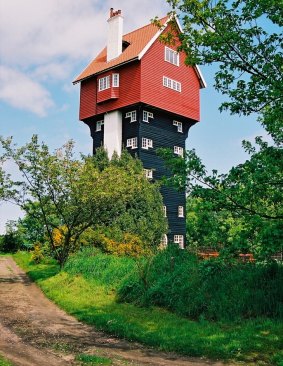
House in the Clouds, Thorpeness.
Our twin room is otherwise spacious enough to accommodate two galumphing blokes, even after a four-course dinner at The Gallery, The Swan's two-rosette winning restaurant.
Our first dinner here is my introduction to Suffolk's gourmet fare and an extravaganza of local ingredients given an innovative twist by head chef Justin Kett.
I begin with crunchy asparagus with pheasant egg, parmesan and maltaise sauce (made with orange, egg and butter), continue onto Suffolk Cod with crab potato and beurre blanc and reach a crescendo with a duck breast accompanied by garlic fondant, rhubarb and broccoli.
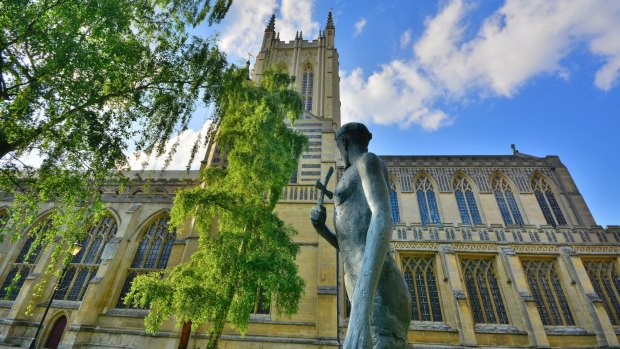
St Edmundsbury Cathedral.
Not for me, though, the excess of a Dark chocolate delice, as this is my year of no desserts to combat middle-aged spread. This leaves Phil to sample his collection of English cheeses, including Cornish Yarg, Montgomery Cheddar and Stichelton Blue.
All through our meal in the background is 28-year-old sommelier Francois Belin, a Frenchman who must have known taste from an early age. Belin helps us choose a different tipple to escort each course, plumbing much of Europe to find the ideal accompaniment.
On this, and every other night, we adjourn to the small Airmen's bar, debating the great philosophical issues of the day, and football, between ourselves and with other guests. It's another sign of a friendly hotel that chats start effortlessly in stand-offish England.
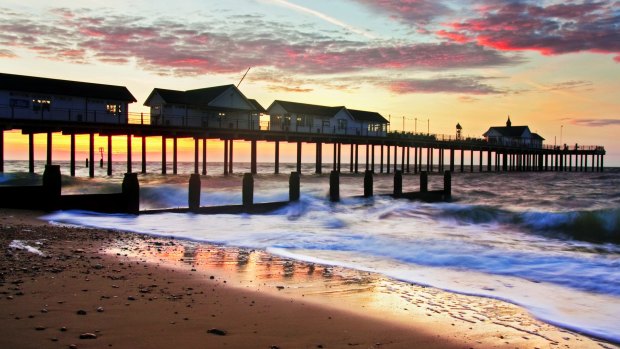
The Southwold Pier was built in 1900.Credit: iStock
In World War II, Lavenham was the base for the 487th Air Bombardment group of the 8th US Army Air Force, known as the "the Mighty Eighth" for flying 185 missions and more than 6000 sorties. Many US airmen took "the boot challenge" at the Swan, attempting to down 3½ pints (1.65 litres) of real ale from a glass boot, in record time, and leaving their signature on the bar wall to celebrate their feat.
Among those who drank at The Swan at the time was big band leader Glenn Miller, who was the world's bestselling recording artist between 1939 and his death in 1943, when the aircraft flying him to entertain US troops disappeared over the English channel.
"During the war, with the nearby air bases," says Claire Partner, our Blue Badge Guide to Lavenham, the following morning, "one in seven of the population here were American airmen."
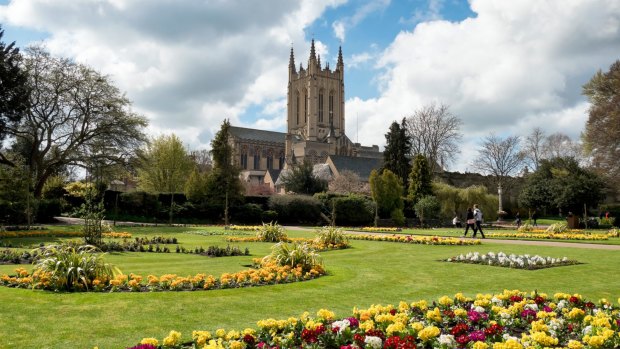
The Abbey Gardens in Bury St Edmunds.Credit: Linda Steward
Long before that, Lavenham, set on a hillock overlooking the Suffolk countryside, was prosperous well beyond its size as a wool-weaving centre. In 1524, there were 47 entrepreneurs worth more than £10 – the equivalent of £1 million ($1.6 million) today) living here.
That wealth was displayed in Lavenham's buildings, foremost among them the lavish, lime-washed Guildhall of Corpus Christi, built in 1529. It is one of the most finely preserved timber-framed edifices in England, completed shortly before the collapse of the wool industry.
Lavenham has 340 listed buildings. These include De Vere house, used as a backdrop in the seventh Harry Potter movie, and Shilling Grange, home of poet and novelist Jane Taylor (1783-1824) who wrote Twinkle, Twinkle Little Star.
Many of Lavenham's buildings come in shades of Suffolk Pink, a terracotta colour infused with animal blood and which celebrity chef Marco Pierre White attempted to emulate, but got disastrously wrong, when painting his Lavenham hotel, The Angel, in 2013.
Lavenham's focal point is its Market Square, unusually standing alone as opposed to on the High Street as in other English period towns, with streets radiating out from it.
We end the day by driving to Bury St Edmunds and take in the immense 1000-year-old cathedral and its gardens before grabbing a cramped pint in Britain's smallest pub, The Nutshell.
But our real business is to eat at Maison Bleue, described as a "must visit" by acerbic food critic A. A. Gill.
The love-child of Brittany-born chef Pascal Canevet and his elegant, front-of-house wife Karine, Maison Bleue produces as good a meal as I've had all year.
The Brittany-style fish soup, with garlic croutons and grated gruyere cheese is "magnifique", the cod ravioli topped with roasted Scottish scampi tail "superbe" and the Creedy carver duck served with chorizo stuffed "ballotine", chicken liver veloute, grilled leek and broad beans is "incroyable".
The following day we journey to the Suffolk coast to take in the English seaside at its Victorian and Edwardian best.
We begin at Southwold, a fishing village turned holiday town, with brightly painted beach huts facing the North Sea and a "pleasure" pier, built in 1900, launching 190 metres into it.
The town also incorporates the Adnams brewery, founded in 1890, and producing a range of beers, including the powerful Broadside Pale Ale, made from natural ingredients like malted barley.
Heading south, we explore Aldeburgh, once home to composer Benjamin Britten (1913-1976). Britten was made Baron Britten of Aldeburgh in the year he died and is commemorated in a four-metre-tall sculpture of a fractured scallop shell, by Suffolk artist Maggi Hambling, set in the midst of its long pebbly beach.
After another sumptuous lunch at the White Lion Hotel on the seafront, we spend the afternoon discovering nearby Thorpeness, with Monica Koch of Wild Adventures.
Strolling around with the encyclopedic, German-born Koch, we're much taken with the strange folly that is Thorpeness.
Developed by Scottish landowner Glencairn Stuart Ogilvie in the early 20th century, it became a private seaside village, including a country club, holiday homes and The Meare, a shallow artificial lake.
"It was designed as a children's paradise with islands like from the Caribbean, a pirate lair and Wendy's home, based on the works of Ogilvie's friend, J. M. Barrie, who wrote Peter Pan," Koch says.
To hide an ugly water tower in the middle of the village, the five-storey "House in the Clouds" was also built, standing out from afar like a fairytale home on giant stilts.
Further south, we visit a much older castle tower, built in 1070 in the scattered seaside village of Orford.
But again the principal reason for our pilgrimage is Suffolk cuisine. For, at the Crown and Castle, next to the castle, is another 2 AA rosette-awarded restaurant, co-owned by food writer and chef Ruth Watson.
The food is another hit with us, from my grilled squid, spiced salami and datterini tomato and roast monkfish tail entree and monkfish, crab and saffron risotto main to Phil's "chocolate Nemesis" dessert.
Back at the Swan in Lavenham, we are drawn once more to the Airmen's bar for a nightcap but remain glued to our seats until the early hours.
After a gastronomic journey that has taken in a thousand years of history, our time in Suffolk draws to a close with tunes like In the Mood by Glenn Miller wafting into my mind, evoking a wartime England infused with an American accent.
TRIP NOTES
MORE INFORMATION
GETTING THERE
British Airways flies daily from Sydney (with connections from Melbourne) to London via Singapore. Economy from $2181 (see ba.com); Suffolk is about two hours drive north-east of London.
STAYING AND EATING THERE
The Swan Hotel, High Street, Lavenham, Suffolk, has rooms from $363 including breakfast, with dinner from $64 (see theswanatlavenham.co.uk). Maison Bleue restaurant is at Bury St Edmunds (see maisonbleue.co.uk); The White Lion Hotel is in Aldeburgh (see whitelion.co.uk); and the Crown and Castle is at Woodbridge (see crownandcastle.co.uk).
TOURING THERE
For the St Edmundsbury Cathedral, see stedscathedral.co.uk; for Monica Koch's Wild Adventures, see wasuffolk.co.uk.
Daniel Scott was a guest of the Swan Hotel, Visit Suffolk and Visit Britain.
Sign up for the Traveller Deals newsletter
Get exclusive travel deals delivered straight to your inbox. Sign up now.